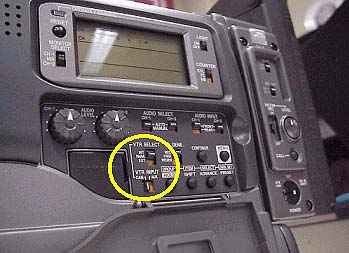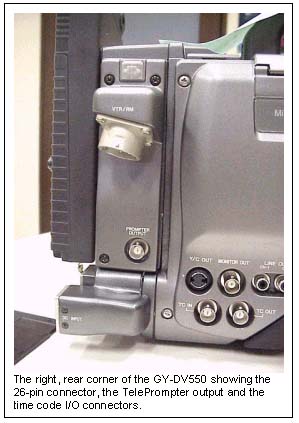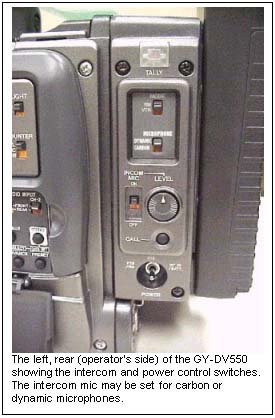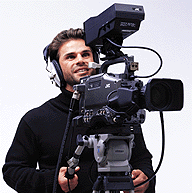Product Details
Sales & Support
Documentation & Visuals
The New, Versatile GY-DV550 from JVC
Every once in a while a video product comes along that captures the imagination of the industry. It has the features, the performance and the price demanded by video professionals. Such was, and for that matter still is, the case with JVC Professional's GY-DV500 Professional DV camcorder.
JVC has done it again with the most exciting DV camcorder yet, the GY-DV550!
Packed with all the features that made the GY-DV500 the industry leader, the GY-DV550 writes a whole new chapter in camcorder versatility.
Do more, do it better, and do it for less!
When JVC introduced the GY-DV500 we said, "Do more, do it better and do it for less." And we proved it! Now, with the GY-DV550 you can do everything the GY-DV500 can do plus a great deal more.
- Need a high quality, light weight, 14 bit DSP, MiniDV ENG camcorder? The GY-DV550 fills the bill.
- A composite video pool feed input is handy in many ENG applications. The GY-DV550 has it.
- The GY-DV550 may be fully genlocked to another camera or other composite video source.
- How about a broadcast standard studio camera complete with studio viewfinder, intercom connection, and camera control unit (CCU)? The GY-DV550 in combination with the new RM-P210 CCU can do that too, an industry first!
- Even in studio configuration you can still record isolated camera views (ISO-CAM) during a live production, making it ideal for parallel shooting at concerts or other "live" events.
- The GY-DV550 provides both 4:3 and letterbox 16:9 aspect ratios.
- The GY-DV550/ RM-P210 combination provides RTS-compatible intercom connectivity with switchable carbon/dynamic microphone. The studio configuration even provides a TelePrompter output at the camera!
The GY-DV550 in the Field…
…In The News…
JVC's engineers have designed the GY-DV550 to be the most flexible DV camcorder ever. Built for a wide range of applications in both ENG and EFP, the DV550 has many features heretofore unavailable in a DV format camcorder.
Often in ENG it becomes necessary to be able to record a "pool feed", a composite video signal supplied by a "host" provider. The DV550 provides just such an input selected by the operator via the VTR INPUT switch on the VTR control panel. The picture below shows this switch in the bottom of the circle.

Many broadcasters continue to use Betacam in ENG and will often demand a news story be provided in that format. Another feature of the GY-DV550 is its ability to "dual record" an event. This is where the 26-pin cable connector and the VTR SELECT switch come into play. The VTR SELECT switch is in the top portion of the circle (above right).
The operator selects INT for the internal (MiniDV) VTR, EXT for the external portable VTR, or DUAL which allows recording on both the internal and external VTRs. Operation is not restricted to only a portable Betacam VTR but also a U-Matic or S-VHS portable deck may be used.
Of course the GY-DV550 has the powerful low light performance of all JVC Professional DSP cameras making it ideal for those "gotta get it" nighttime shots.
…EFP On The Move…
The GY-DV550 is ideally suited to today's EFP applications. First and foremost is the quality of the camera section of this amazing camcorder. It utilizes three ½ inch CCDs and JVC's 14 bit Digital Signal Processing (DSP) to provide the picture quality demands of not only MiniDV but, through the 26 pin connector Betacam SP and yes, even D9!
The DV550 is also fully genlockable meaning it may be synched to another DV550, another camera or camcorder, or to an another external source. All that is required is a stable composite video signal connected to the SYNC IN connector located near the front, non-operator side of the camcorder.
Further, the GY-DV550 has both a TIME CODE IN and a TIME CODE OUT connector (BNC) which allows the camcorder "jam" to the time code from another camcorder or from an external source. Time code, as with the DV500, is SMPTE code with userbits and is user selectable for either Drop Frame (DF) or Non-Drop Frame (NDF) modes.
The GY-DV550 is also equipped with an on-camera 6-pin port compatible with JVC's RM-LP55 (handheld) and RM-LP57 rackmountable remote control units. These give an operator the ability to "paint", control the iris and black levels of the DV550.
The GY-DV550 has an IEEE 1394 (Firewire) input/output compatible with most NLE systems. This allows high-quality compressed digital video signal transfer directly to a computer, a non-linear editing system such as Apple's Final Cut Pro, or to another DV recorder. Producers can now digitally spool directly to a non-linear editing platform without loss, and then transfer the finished product directly back to video tape using the camera alone.
A four-inch viewfinder, the VF-P400U is available, as are studio-style lens controls. These optional accessories further enhance the operation of the GY-DV550 in EFP applications.
The GY-DV550 system provides a full digital signal path from the camera to the recorder. No analog interconnect to the recorder here!
The GY-DV550 in the Studio…
In today's cost-conscious production environments, being able to use a camcorder for more than one application is most desirable. And the GY-DV550 fits the bill!
The 26-pin connector on the DV550 not only allows the connection of a portable VTR of a range of formats, it also allows the camcorder to be connected to a sophisticated yet cost-effective Camera Control Unit, the RM-P210U. The DV550 also connects with our existing camera control units, the RM-P200 and RM-P300.
Some of the many features of the RM-P210U/ GY-DV550 system include:
- Full access to the camera's menu system
- RTS four wire or two wire Intercom
- Continuously variable gain control
- Can use either JVC or Sony 26 pin camera cable (GY-DV550 only)
- Composite, Y/C (S-Video), RGB and Component analog outputs
- The DV550 has two easy to see large bi-color rear tally LED's - green for PREVIEW and red for TAKE
- Teleprompter video output at the camera
When connected to a camera control unit, the GY-DV550 may still be used as a camcorder. The camera's output, while going to the CCU via the 26-pin cable and the video switcher, may still be recorded by the integrated MiniDV VTR. This is called ISO-CAM recording.
The GY-DV550 records Time and Date with seconds resolution which may be superimposed over the recorded video (menu selectable), an ideal feature for court required recordings.


The GY-DV550 is undoubtedly the most versatile MiniDV camcorder on the market today. The feature set and overall performance of this camcorder belie its amazingly low price.
The added benefits of being able to use the DV550 in either studio or EFP/ENG configuration, ISO-CAM recording, and the ability to record on other formats including D9 are unparalleled in the industry.
Do more, do it better and do it for less!
|
|
|
|
| Availability | Now | Discontinued |
| Synchronization | Internal/Genlock | Internal/Synclock |
| Lens mount | "1/2"" Bayonet" | "1/2"" Bayonet" |
| Optical filter | Four position | Three position |
| Electronic gain | "0,3,6,9,12,18dB,LOLUX,ALC" | "0,6,9,12,18dB,LOLUX,ALC" |
| S/N | 62dB Camera VIDEO Out | 62dB (typical at camera) |
| Horizontal resolution | 750 TVL (26-pin OUT) | 750 TVL (camera) |
| Power consumption | 28 Watts | Approx.: 20 Watts |
| Manual knee | Yes | No |
| 16:9/4:3 Switchable | Letter box | No |
| Tally |
On rear panel: VTR + CCU Green = PREVIEW; Red =TAKE |
On rear panel VTR: |
| Camera (TEST) output | Encoder + camera menu | No |
| CCU Remote connection | via 26-Pin (camera control only) | No |
| External reference | Full Genlock | Synclock |
| EFP Remote (LCU) | via 6-Pin (camera control only) | No |
| Time & date | Superimposed | Yes; AUX DATA |
| Composite video input | same as GENLOCK | No |
| Reference audio level | -12dB (consumer) -20dB | -20dB |
| Audio input | 2 (XLR) | 3 (XLR) |
| Headphone output | Stereo mini jack: (monaural) | Mono mini jack: (monaural) |
| Time Code input | BNC | No |
| Time Code output | BNC | No |
| 26-Pin connector | Full CCU or backup VTR | No |
| Back-up VTR connection | DV out (IEEE1394) & 26-pin | DV (IEEE1394) out |
| Tripod mounting plate | Sony type | JVC original attachment |







